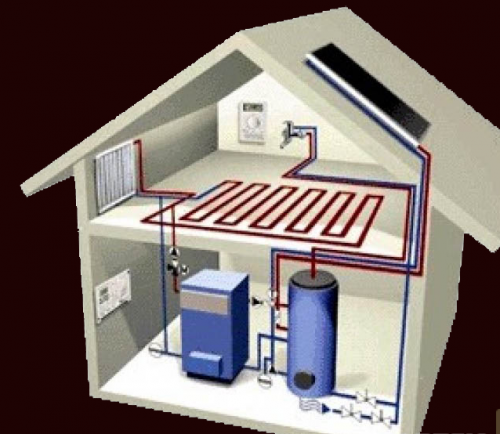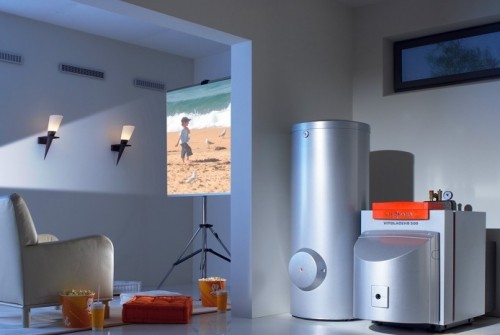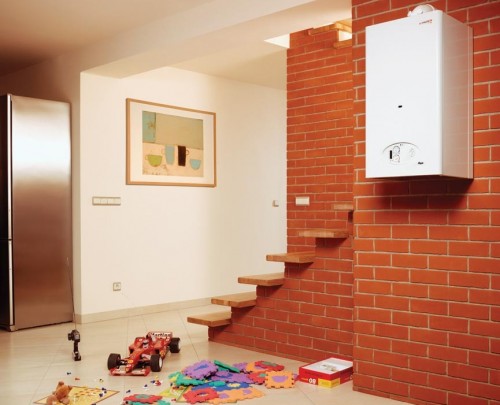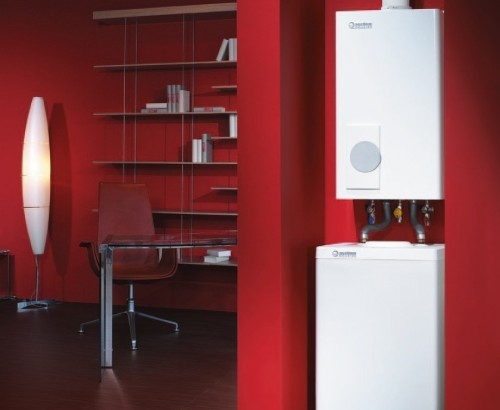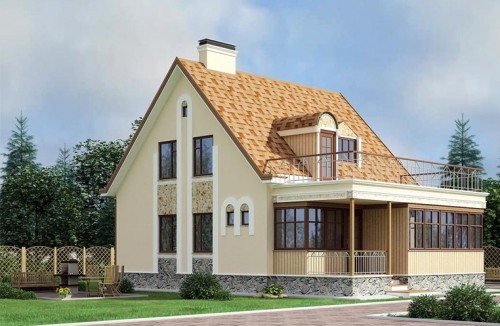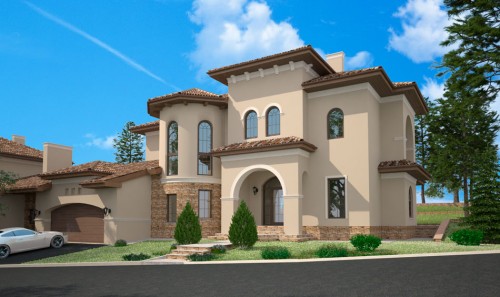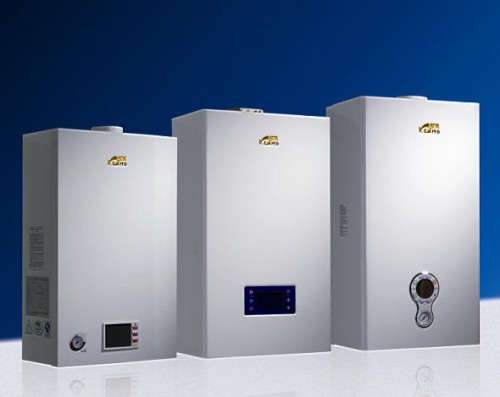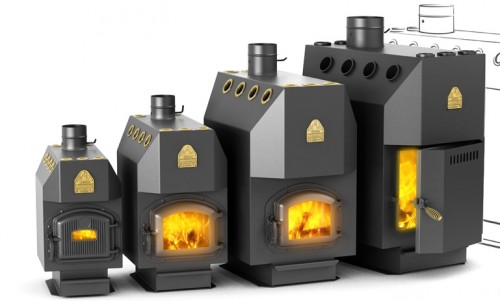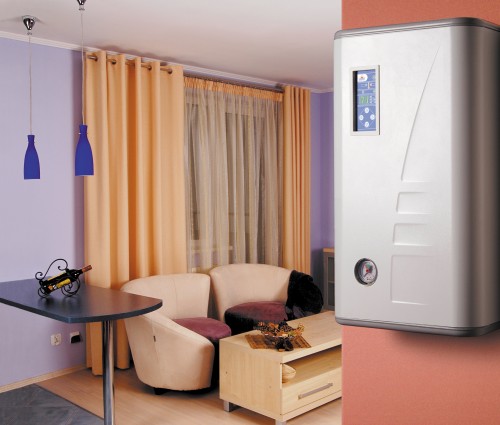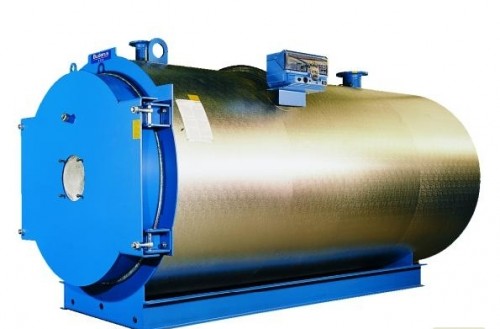
Calculation of boiler power Climate
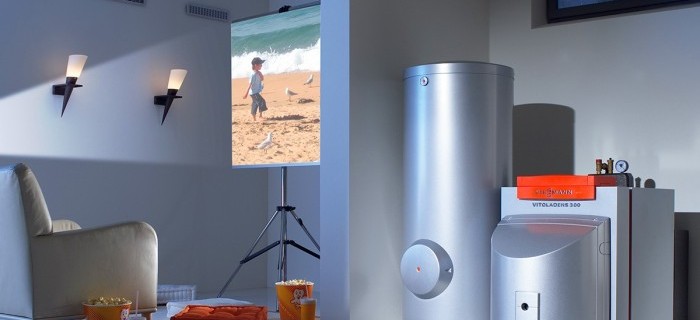
The heating system is the most important, complicated and expensive of all housing communications. The arrangement of heating requires careful design to avoid unpleasant consequences that are often difficult to correct.
Content
- Main types of heating equipment
- Calculation of the power of the heating boiler on the area of \u200b\u200bthe room
- How to calculate the real heat loss of the structure
- Calculation of the power of the gas boiler heating
- Calculation of the power of the gas boiler using the Calculator program
- Calculation of power solid fuel boiler
- Calculation of power of electric boiler heating
- How to calculate the power of a liquid fuel boiler
Main types of heating equipment
The market of heating equipment presents a large selection of boilers. Many models differ from each other by design, source of energy, power. Boilers are produced with a power range: from 4 kW to several thousand kW. Thus, there is an opportunity to choose the optimal suitable boiler for the building of any dimensions, both for a country house and a country cottage. The choice of a boiler of a type or other type: solid fuel, electric, liquid-fuel or gas largely depends on the region of residence and the level of infrastructure development. It is important is the availability of a certain type of fuel and its cost.
One of the key moments of housing heating planning is the calculation of the boiler power, while it is necessary to take into account the features characteristic of systems operating with different types of heating. Errors in the selection of boiler power are not allowed, moreover, both its excess and a decrease. With insufficient boiler power, the house will be cold. Excessive power will result in overvoltage of electricity or fuel.
Calculation of the power of the heating boiler on the area of \u200b\u200bthe room
One of the main conditions for comfortable housing is the presence of a well-thought-out heating system. The type of heating and the required equipment is chosen at the design stage of the house. Determining the power of the heating boiler by area allows you to get quite objective data.
Basic calculation rules and parameters used in calculations:
- Schedule area (S).
- Specific capacity by 10 m² heated area - (Wood). This value is determined with the adjustment on the climatic conditions of the individual region.
- Wed. For the Moscow region is - from 1.2 kW to 1.5 kW.
- For southern regions - from 0.7 kW to 0.9 kW.
- For the northern zone - from 1.5 kW to 2.0 kW.
- The boiler power is calculated by the formula: WKOT \u003d (SXWD): 10.
It is possible to use a simplified variant of the formula, in which Wood \u003d 1, and the heat transfer of the boiler is measured as 10 kW per 100 m² heated area. With this calculation, at least 15% add to the resulting value to obtain a more real figure.
Example: Calculation of the power of the boiler heating for a house of 100 m².
Specific power for the Moscow region is 1.2 kW.
Thus, WCOTL \u003d (100Х1,2) / 10 \u003d 12 kilowatt.
For a more accurate calculation of the required power of heating devices, you need to collect an extended list of data:
- Real heat loss room. Heat leakage of any building occurs through doors, windows, roof, floor, walls, ventilation system.
- The difference in temperature inside the building and on the street. When calculating the power of the heating boiler, take into account the difference in temperature indoors and beyond. The greater the difference in temperature values, the greater the heat loss.
- Thermal insulation characteristics of building structures. The heat-conducting properties of doors, windows, walls and floor depends on the material from which they are made, therefore, heat loss through their surface will also have differences.
To obtain the necessary indicators and coefficients in determining the capacity of the boiler, use the construction directory.
How to calculate the real heat loss of the structure
Heat is lost from the room through the walls, windows, gender, roof, ventilation system. Many factors affect the heat lines: the difference between the temperature inside the building and on the street, the heat-conducting properties of building materials. The thermal conductivity of walls, doors, windows, gender and ceiling overlap differs from each other. The unit for measuring the heat transfer resistance serves W / m2, this characteristic means the amount of heat of the heat with 1 m² of the enclosing structure at a certain temperature range.
Formula No. 1 to determine the resistance of heat transfer: R \u003d Δt / q
- R is heat transfer resistance (° CHS² / WT or ° C / W / m²);
- Δt - temperature difference in the street and in the building (° C);
- q is the number of heat loss per square meter of the surface of the enclosing structures (W / m²).
When determining the heat transfer resistance of multilayer structures, the heat transfer rates of each layer are summed up. This calculation takes into account the average temperature on the cold weather street for the year per year, the reference sources indicate the heat transfer resistance based on these conditions. For example, the heat transfer resistance of materials at Δt \u003d 50 ° С (TSNAK \u003d -30 ° C, twrench \u003d 20 ° C).
When determining the heat-conducting properties of windows, it is taken into account:
- Resistance to heat transfer materials of window structures and their heat loss with Δt \u003d 50 ° C. Glass thickness (mm).
- The thickness of the gap between the glasses in mm.
- The type of gas filling the gap: air or argon.
- The presence of a transparent heat protection coating.
A common error is the opinion that heat loss can be compensated by choosing a boiler of greater power. In fact, it is more reasonable to prevent unwanted heat loss at the expense of the thermal insulation of windows, roofs, doors than to overpay for gas or electricity monthly. Some double-glazed windows reduce heat loss of approximately 2 times, which saves 800 kW / h electricity per month. More accurate heat loss is calculated by the proportion method.
Formula No. 2 to determine the resistance of heat transfer structures from combined materials: R2 \u003d R1xΔt2 / Δt1
R1 - heat loss with a temperature difference Δt1 \u003d 50 ° C;
R2 - heat loss with temperature difference Δt2 in accordance with specific data.
An example of calculating the heat loss of the wall:
- Wall thickness 20 cm,
- Wall material - log cabin. In the reference book of the materials, the impedance value of heat transfer R. For a bar R \u003d 0.806 m² × ° C / W.
The temperature difference Δt is 50 ° C. Substituting the values \u200b\u200bin Formula No. 1:
R \u003d ΔT / Q, obtain the value of heat loss for 1m² 50 / 0.806 \u003d 62 W / m².
Similarly, the heat loss and for all other materials are determined. The larger the temperature difference on the street and inside the Δt building, the higher the heat loss.
Most of the construction reference books for the convenience of calculation are the prepared indicators of the heat loss of various types of building structures during individual air temperature values \u200b\u200bin the winter.
For example, the heat loss of angular premises, where the influence of air is affected, and not angular, as well as the premises on the upper and lower floors, which are also distinguished by the degree of heating.
Example: Calculation of the heat loss of the corner room located on the first floor
1. Source room parameters:
- sizes and area - 10.0 m x 6.4 m, S \u003d 64.0 m²;
- ceiling height - 2.7 m;
- the number of external walls - 2;
- the material and thickness of the outer walls is masonry in 3 bricks (76 cm);
- the number of windows with double glazing - 4;
- windows dimensions: height - 1.8 m, width - 1.2 m;
- paul - Wooden insulated;
- overlap: down - the basement, upstairs - an attic room;
- estimated temperature in the room + 20 ° C;
- calculated temperature on Street -30 ° C.
Calculated actions:
2. First calculate the surface areas that lose heat.
Exterior wall area excluding windows (SESN): (6.4 + 10) x2.7 - 4x1.2x1.8 \u003d 35.64 m². Window area (Sokon): 4x1.2x1.8 \u003d 8.64 m². Ceiling area (SPoter): 10.0x6.4 \u003d 64.0 m².
Floor area (SPOL): 10.0x6.4 \u003d 64.0 m².
There are no indicators of the area of \u200b\u200binternal partitions and doors in this calculation, so the heat loss does not occur through them.
3. Determine the heat transfer resistance for the brick wall:
R \u003d Δt / Q, where Δt \u003d 50, and q brick wall \u003d 0.592
Thus, R \u003d 50 / 0.592, and is 84.46 m² × ° C/WT.
4. Next, calculate the heat loss Q of all surfaces of the enclosing structures:
- QOTEN \u003d 35.64х84,46 \u003d 2956.1 W,
- Quone \u003d 8.64x135 \u003d 1166.4 W,
- Quol \u003d 64 × 26 \u003d 1664.0 W,
- Quoted \u003d 64x35 \u003d 2240.0 W.
Total: the sum of the heat loss room of 64 sq.m. Qsum \u003d 8026.5 W.
In this example, the largest heat loss comes onto the walls, to a lesser extent on the ceiling, floor, windows. The result of the calculation reflects the thermal loss of the room into severe frosts at a temperature of -30 C °. The higher the air temperature on the street, the less heat leakage from the room.
Calculation of the power of the gas boiler heating
Gas boiler for autonomous heating of a private house enjoys well-deserved popularity. Such a system is convenient, available and effective. And if the house is remotely from the central heating network, then there is simply no other alternative. Household gas boilers in most cases are the most optimal option of the heating system due to such indisputable benefits as: simplicity and safety of operation; No need to assign a fuel storage space, low fuel price, efficiency.
It is very important when buying a gas boiler to choose the right power to choose a suitable power. If the power exceeds the real needs of the building heat, the cost of heating will be redundant. On the other hand, low productivity equipment is not able to provide sufficient heating of the room. The most elementary calculation of the power of the gas boiler in Square: 1 kW for every 10 sq.m. But such results are very approximate. To perform a more accurate calculation of the power of the gas boiler, take into account a number of factors:
- climatic conditions of the region;
- dimensional room dimensions;
- the degree of thermal insulation of the house;
- probable heat loss building;
- the amount of heat for heating water;
- the amount of energy for air heating in the system of forced ventilation.
As a rule, the calculations use a special software: for the backup power of the gas boiler, approximately 20% is added in case of a strong cooling, lowering gas pressure in the system or other unforeseen situations. Modern heating devices are equipped with an automatic device regulating gas consumption. It is convenient, as it eliminates the overpowering of fuel and unnecessary costs.
Many mistakenly consider the calculation of the power of the boiler of heating is excessive formality, and that you can simply buy a gas boiler with high power. In fact, the unreasonable excess of the heating equipment can cause the need to purchase components, and therefore increased costs of repairing the system, a decrease in the functional efficiency of the boiler, interruptions in the operation of an automatic device, rapid wear of the elements, the appearance of condensate in chimneys and other negative consequences.
Calculation of the boiler power and the correct selection of heating equipment will contribute to an increase in its life. When choosing a gas or other boiler, it is required to carefully study the accompanying documentation. The instructions of the heating boiler indicates the rated power, which is produced at a nominal pressure of natural gas 13-20 mbar. Reduced pressure in the highway will lead to the fact that the boiler is power, for example, 30 kW will lose one third of its power. In this case, the boiler will be able to effectively warm the house with an area of \u200b\u200bonly 200 sq. M, instead of the calculated 300.
The formula for the required power of the gas boiler for buildings by typical project: m TO \u003d SHUM. TO/10
- M. TO - the calculated power of the boiler (kW);
- S is the total area of \u200b\u200bheated premises (sq.m);
- MIND TO - Specific capacity of the boiler in the calculation for every 10 square meters of the surface. The specific capacity of the boiler depends on climatic conditions and is: 0.7-0.9 kW for the southern regions; 1.0-1.2 kW for medium strip regions; 1.5-2.0 for the northern regions.
Example: According to the formula, the calculated power of the heating boiler for a house of 200 square meters, located in the zone of moderate climate, will be: 200x1.1 / 10 \u003d 22 kW.
It should be remembered that this formula is used to calculate the boiler power, subject to use it only for home heating. If you plan to install a two-circuit system in order to heat water for household needs, then additionally increase the power of the heating equipment by 25%.
In order to correctly calculate the power of the gas heating boiler for the house with a non-standard layout for individual order, use another formula.
Formula for calculating the power of the gas boiler for buildings by an individual project: m TO \u003d QTKCAP,
- M. TO - the calculated power of the boiler (kW);
- QT - predicted thermal losses (kW); KAZ - stock coefficient equal to 1.15-1.2, (15-20%).
The magnitude of the predicted heat loss of the structure is determined by the formula:
Qt \u003d VHRTXK / 860
- V is the volume of heated premises (cubic meters);
- Rt is the difference in street and internal temperature (C);
- k - dispersion factor.
The magnitude of the dispersion coefficient depends on the type of building structure and the degree of heat insulation. For buildings in the form of simple structures of wood or corrugated iron without heat insulation, a dispersion coefficient is used 3.0-4.0.
If the walls of the building with single brick masonry, standard windows and roof, low thermal insulation, then the dispersion coefficient is 2.0-2.9.
For mid-level houses, thermal protection, with a double brick masonry walls, a conventional roof and a small number of windows, the dispersion coefficient is 1.0-1.9. For houses with a high degree of heat protection, well insulated floor, roof, walls and plastic windows with double double-glazed windows, the dispersion coefficient is 0.6-0.9.
The calculated power of the heating boiler for compact buildings with high-quality thermal insulation may be quite small. It is possible that the sale of a suitable gas boiler with the required characteristics will simply not be on sale. In this case, equipment is acquired, the power of which slightly exceeds the calculated value. Many modern modifications of gas boilers are equipped with automatic heating control devices that allow to align the difference.
Calculation of the power of the gas boiler using the Calculator program
For the convenience of customers, gas boilers make special services on their web resources, which makes it easy and quickly calculating the calculated boiler power. To do this, just enter the following data in the Calculator program:
- the temperature is expected to maintain indoors;
- average street temperature for the coldest week during the year;
- the need for DHW;
- the presence or absence of a forced ventilation system;
- number of floors in the house;
- ceiling height;
- description of overlaps;
- the dimensions of the outer walls: the thickness and length of each of them;
- description of materials from which walls are made;
- the number and size of windows;
- description of the type of windows: the number of cameras, glass thickness, heat shield film, gas type in gaps.
After filling all the fields, click the "Perform calculation" button, and the program will display the required calculated boiler power.
For even greater convenience, options for ready-made boilers of various types of boilers are visually presented in tables. It should be borne in mind that for complex buildings these methods of calculation may not come up. For example, the presence in the building of the premises of the ceilings of different heights, a heap system, structures requiring additional heating (pool, greenhouse, sauna). All these conditions should be taken into account when designing. With any additional load on the heating system, an increase in boiler power is required.
The most optimal calculation of the power of the heating system will be able to prepare only specialists, heat engineers.
Calculation of power solid fuel boiler
Solid fuel boilers have recently been applied significantly less often electrical and gas. They are characterized by the availability, the possibility of offline operation, economical operation, the need for a place to store fuel.
A distinctive feature that should be considered when determining the power of a solid fuel boiler is the cyclicality of the temperature obtained. The daily temperature in the heated room ranges in the range of 5ºС. If there is no possibility to abandon such a system, there are two ways to maintain a stable room temperature: the use of thermobalone and the use of water heat accumulators.
The thermobalon serves to adjust the air supply, which allows you to increase the combustion time and reduce the amount of furnace. Water thermoaccumulators of 2 to 10 m² are installed in the heating system, reduce energy consumption and save fuel. All these measures contribute to a decrease in the required performance of a solid fuel boiler for the heating of a private house. The effect of the use of these measures should be considered when determining the power of the heating equipment.
Calculation of power of electric boiler heating
The heating system with an electrocotel is characterized by a number of positive and negative features: the high cost of fuel - electricity, possible problems due to power supply interruptions on the network, environmental friendliness, simplicity and ease of control, equipment compactness.
Calculation of the power of the electrocotel heating using the Calculator program
Often, manufacturers of heating equipment place on their sites of the formula for calculating the power of the boiler or even calculators that allow you to take into account several defining factors at once and make the most accurate calculation.
To calculate the calculator, as a rule, the following information is required:
- Planned room temperature.
- The average temperature on the street is the coldest week of the year.
- The need for DHW.
- The presence of the ventilation system.
- Number of floors.
- Ceiling height.
- Overlapping top and bottom.
- Material. Outdoor walls.
- Length and thickness of exterior walls.
- Number, type and size of windows.
- Glass thickness. The magnitude of the gap between the glasses with air or argon. The presence on the glass of heat-shielding transparent coating.
It should be borne in mind that in reality the specific power of the heating system increases to a value of 127 W / m 2 With a small area of \u200b\u200bthe house (100-150 m 2) and decreases to 85-80 W / m 2 For houses area 400-500 m 2that does not match the adopted standard value of 100 W / m 2which is usually recommended for selection of equipment.
This is caused by the fact that in houses with a small area is inefficiently spent heat consuming. With an increase in the total area in the house there are more premises, adjacent with heated, as well as without exterior walls and located in the depths of the house. As a result, the specific heat loss of the house is somewhat declined.
How to calculate the power of a liquid fuel boiler
Heating liquid fuel boilers have both advantages and disadvantages: they are easy to operate, but non-soldered, require additional fuel storage space, differ in high fire hazard, have a fairly high cost.
The calculation of the power of the liquid fuel boiler is made similar to gas and electric. The more factors affecting the effectiveness of the heating system, the more precisely the calculation will be calculated, which in turn will make it possible to make the optimal choice of equipment.
The quality of heating primarily depends on the proper selection of the type of heating system and on the accuracy of the calculation of the necessary performance of the heating boiler. Design errors will inevitably lead to negative consequences. Therefore, it is very important before buying the heating equipment and installing the system to assemble complete information, perform thorough calculations and planning.





